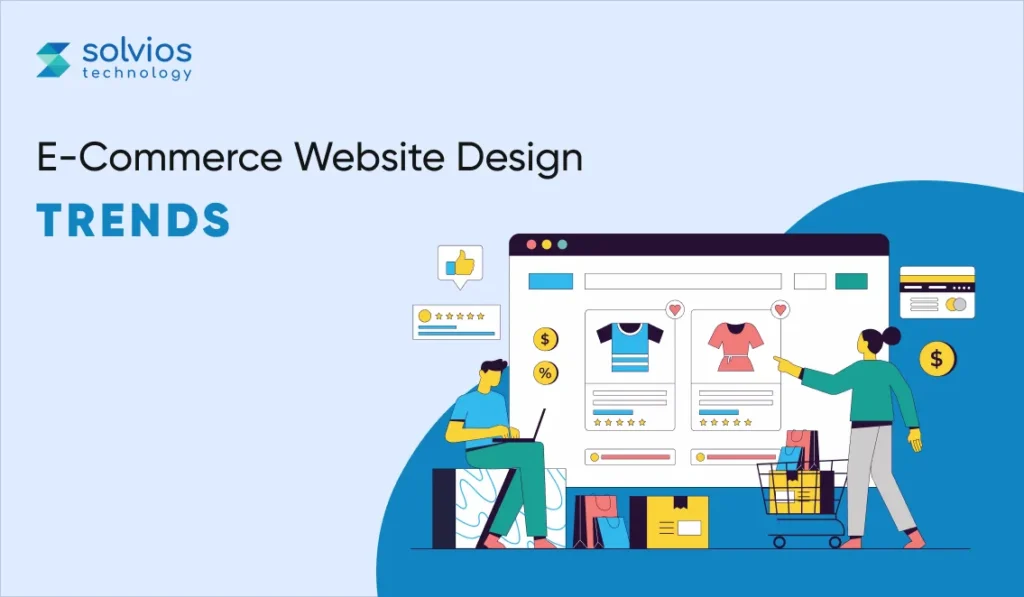Table of Contents:
- Introduction to Ecommerce Web Design
- Importance of Staying Up-to-Date with Design Trends
- Common Mistakes in Ecommerce Web Design
- Slow Loading Times
- Poor Mobile Responsiveness
- Confusing Navigation
- Cluttered and Inconsistent Design
- Lack of User-Friendly Features
- How to Avoid These Mistakes
- Conclusion
- FAQs:
Introduction to Ecommerce Web Design
Ecommerce Web Design Trends: Nothing beats the rush of shopping online and making that all-important order. A good ecommerce website can help sell a product, while a bad website will drive customers away. An ever-changing landscape of consumer tastes also guarantees that ecommerce web design innovation is nonstop. Knowing the proper design elements will capture more customers and sales if you launch a new website or refresh an old one.
Please proceed with caution; while chasing the latest fads is good, they should not compromise the success of your ecommerce business. There is always a hidden danger in web ecommerce design, from lack of speed to poor structure, the challenges abound. To help ensure your visitors turn into loyal customers, let’s explore these blunders so customers return to your site repeatedly.
Importance of Staying Up-to-Date with Design Trends

Staying updated with ecommerce web design trends is necessary for standing out in the online marketplace. With the pace of change, anything appealing in the past may look outdated today.
A modern and clean design boosts the user experience and enhances conversion rates.
Fresh-looking websites with engaging content attract more customer activity. An outdated website can lose business as competitors with better design aesthetics gain more customers.
In addition, a more significant portion of the population now browses for products through mobile devices than ever before. Ensure your design is responsive to allow effortless shopping on all devices.
Differentiating yourself from competitors can be accomplished by embracing AI-driven features or using augmented reality. These innovations open new ways for users to engage with products online and are very interesting.
Tracking industry trends puts you in a position to effortlessly meet customer demands, which helps showcase relevance. Changing current strategies also improves visitors’ credibility and fosters trust.
Common Mistakes in Ecommerce Web Design
Ecommerce sites are essential for the expansion and progress of an internet business. Sadly, many companies make basic errors that hinder their chances for success.
A slow-loading website will irritate customers. If your website takes an above-average time to load, potential customers will leave without seeing your products and services.
Brands face another challenge: a lack of mobile responsiveness. Considering that mobile traffic is expected to increase, not being able to cater to smaller screens can lead to a loss of huge amounts of business.
Difficulty in understanding the site structure destroys the shopping experience. Visitors who cannot locate the products or information in a reasonable time frame will most likely abandon their shopping carts.
An inconsistent and cluttered website design is visually confusing. With so many objects competing for attention, visitors cannot focus on the most important details.
A lack of helpful features such as search boxes or filters will frustrate users while browsing the web. Mistakes like this could cause you to lose sales opportunities and damage your reputation.
Slow Loading Times
Slow loading times on your e-commerce website could be a deadly drawback, hampering business. Customers want to access products and information efficiently, and waiting too long will bring frustration.
Research shows that merely a one-second delay can lead to shocking falls in conversion rates. Users consistently abandon websites that do not load quickly enough to meet expectations.
Bulky images, heavy scripts, and even some hosting services can contribute to slow loading speeds. All of these reasons may cause a potential buyer to abandon the purchase in the end.
Browser caching can significantly improve loading times and optimise image ratios. Additional servers in different geographical locations, termed content delivery networks (CDNs), should also be utilised. Site speed must be evaluated frequently, and www.google.com/speed/pagespeed/insights/ is a valuable tool. Do not ignore numbers; they will help us all greatly in the end. Make sure to monitor them.
Poor Mobile Responsiveness
Poor mobile responsiveness can drastically hurt your ecommerce success. With the number of users shopping through smartphones increasing, an inbound website serves an source of potential.
Now, visualise a potential customer coming to your site only to be met with poorly placed images and tiny buttons that are impossible to push. They quickly get frustrated when they realise they can’t navigate the site, resulting in lost sales and abandoned carts.
Moreover, sites such as Google prefer mobile-responsive sites in their rankings. Not investing in design optimisation puts you at risk of being outperformed by competitors who maintain responsive designs.
Optimisation isn’t only an aesthetic concern; it also involves functionality. Building trust and engagement from visitors encourages further increases in conversions.
Investing time in improving your webpage’s mobile design is imperative to succeed in this market.
Confusing Navigation
A visitor to an ecommerce store should feel that browsing the site is uncomplicated and simple. Unfriendly navigation systems tend to frustrate users and customers. Customers become frustrated with navigation, leading to unsold purchases and a reduced revenue.
Shopping on a website can be challenging for visitors when encountering an unclear menu arrangement. If any categories are not neatly described, shoppers will abandon their search altogether. It is more critical than you might imagine that the interface is appropriate.
Dwell deeper on the ways information can be structured. It is essential to ensure that critical content pieces do not require endless scrolling or clicking to access. Making the defined pathways easier guides customers to the deeper parts of your store.
Comprehension and interpretation of the visual information give direction and reason. Distinctive colors or fonts that differentiate active sections enable smooth navigation throughout the site.
Do not hesitate to test and review your site’s navigation with real customers. Their experiences might provide assistance that can overrule open and sometimes hidden challenges when using the interface you have designed.
Cluttered and Inconsistent Design
An inconsistent website design will turn customers away quicker than you would think. An overload of features on a website can overwhelm visitors, creating an overwhelming experience. This often results in frustration, walking away without a potential purchase made.
The use of various styles and color combinations is more disorderly than organised. If a design is chaotic, its corresponding brand value is equally bad. Users hate dealing with complex layouts; they only know where to click.
Every other trend in ecommerce website design allows more use of blank space. This also includes leaving out specific details. Whitespace provides a space for the products and information to rest and lets users focus their eyes on the page.
Creating a visually appealing, cohesive design requires much effort to improve the site’s performance. A more refined experience encourages customers to stay longer and examine the site before buying something.
Lack of User-Friendly Features
If you think a lack of a user-friendly approach will just annoy a customer, think again. Having an intuitive interface is the most critical requirement when a customer is shopping online.
Numerous ecommerce businesses always miss the mark with basic advanced functions like search filters or a wish list. These functions serve a vital purpose in eCommerce, and that is improving customer experience.
Your customers also desire a swift purchase process, so it needs to be simple. If your customers need to provide additional information to complete their purchase, they may leave the cart as is.
Differently able people need text-to-speech functions and a reasonable font size. Adding these options makes usability much broader and better for everyone.
Live chat or a detailed FAQ section can drastically enhance customer support, so add those. Immediate support helps build faith and trust, which results in better sales.
Adopting the previous suggestions improves customer satisfaction and gives them reasons to return. Enhancing user experience compared to your competition can drastically improve your market strategy, as most tend to forget this critical aspect of design.
How to Avoid These Mistakes
Avoiding expensive errors in ecommerce websites begins with adequate research so you understand your potential clients’ interests and habits. This will assist in guiding your design decisions accordingly.
Second, prioritise speed. Compress images and use best coding practices to achieve quick load times. Use Google PageSpeed Insights to see where improvements can be made.
Mobile friendliness is essential nowadays. Implement responsive designs, so users have a uniform experience regardless of their devices.
Navigation should be easy. Menus should be arranged in a sensible order, with a visible search option.
Using consistent brand elements increases trust. Maintain a cohesive color scheme, font style, and images throughout the website.
Include supportive features like chat windows and easy-to-use checkout systems. These features improve customer satisfaction while also lowering bounce rates.
Test your website regularly across different devices and internet browsers to uncover problems that may affect your users negatively.
Conclusion
Ecommerce websites are constantly updating their designs, so understanding and keeping up with them is essential. If online businesses fail to comply with set design standards, the mistakes made can, in addition to harming sales, escalate to a very bad user experience.
Instead of waiting until the website is complete and then troubleshooting, it is better to outline possible problems, such as cluttered designs, a lack of friendly features, poor navigation, poor mobile responsiveness, and slow loading times.
Following common practices in e-commerce web designs will increase visitor satisfaction and enhance the site’s usability. Addressing these issues will pay off in the long run, as ensuring customer satisfaction will go a long way in brand loyalty; modern times dictate that the shopping experience be pleasant.
Keeping up with new developments and ensuring that mistakes aren’t repeated goes a long way toward building the perfect online store. This gives better chances of attracting shoppers and converting them into loyal customers.
FAQs:
What are ecommerce web design trends?
E-commerce web design trends focus on minimalism, mobile optimisation, and AI product recommendations.
Why are mobile-friendly designs important in ecommerce?
Mobile-friendly designs ensure smooth shopping experiences on mobile devices, a key trend in ecommerce.
How do ecommerce web design trends improve user experience?
They enhance navigation, speed, and personalized shopping, making it easier for customers to browse and buy.
What role do interactive features play in ecommerce design?
Interactive elements like hover effects and 360-degree views increase engagement and product exploration.
How do ecommerce web design trends boost conversions?
Simple designs, fast checkouts, and trust signals help convert visitors into customers.
What ecommerce web design trends are expected in 2025?
Voice search, AR/VR, and AI chatbots will dominate ecommerce web design trends 2025.
How do ecommerce web design trends affect SEO?
Optimised site structure, images, and fast loading times improve search rankings.
Why is personalization a key trend in ecommerce design?
Personalization tailors the shopping experience to customers, increasing engagement and sales.
How do visuals impact ecommerce web design trends?
High-quality images and videos are crucial for showcasing products and attracting buyers.
How do ecommerce web design trends ensure security?
Secure payment options, SSL certificates, and two-factor authentication enhance site security.
